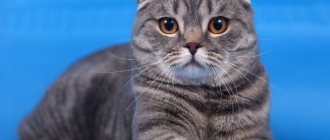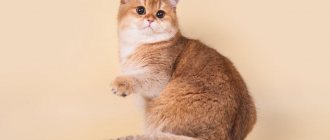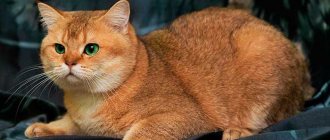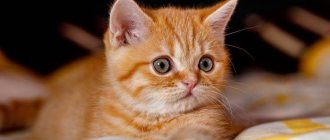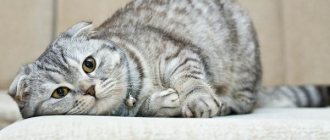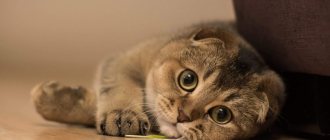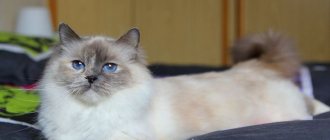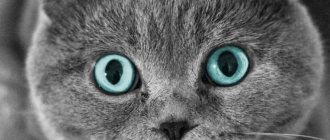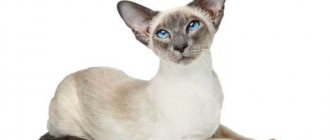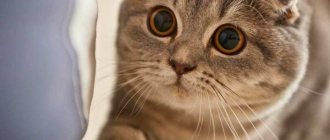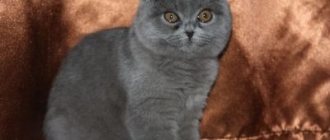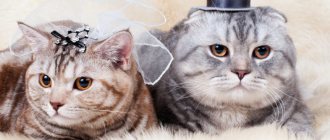The Scottish Straight or Scottish Straight is a type of Scottish breed. Translated from English, scottish straight literally sounds like “Scottish straight”. Cats are distinguished by plush fur and erect ears. Felinologists distinguish four varieties of Scottish cats: Scottish Straight, Scottish Fall, Highland Straight and Highland Fold. Highland means "semi-longhair".
In this article we will talk about the amazingly beautiful, narcissistic, intelligent and self-sufficient representatives of the Scottish Straight breed.
History of the Scottish Straight breed
The Scottish Straight breed is the same as the Scottish Fold, only with a modified structure of the auricle. Simply put, folds are lop-eared, straights are straight-eared, without a characteristic crease. This is the only exterior feature that distinguishes straights from folds.
The Scottish Shorthair cat is considered the youngest breed. The first kitten with flattened ears appeared in Scotland on one of the farms in the 60s. The ancestor of the Scottish cat had no pedigree and was an ordinary cat that chased rodents around barns.
According to official data, the first breeder of the breed was William Ross, a peasant who took into care a kitten from a fold-eared cat. Later, breeders joined the breeding process. Experts noticed an interesting feature: kittens with straight ears periodically appeared in litters of purebred Scottish cats. They were in no hurry to separate them into a separate breed, since they considered straight ears to be a defect, and such kittens were not popular. However, nature itself entered the arena.
Soon, breeders noticed that attempts to consolidate lop ears as a breed trait led to a deterioration in the health of the animals. The gene that is responsible for flattened ears inhibits the function of the bone apparatus, which has led to thickening of the bones and osteochondrodysplasia. The breeders decided to look for “fresh blood” in order to reduce the number of genetic pathologies.
Using the outcrossing method, breeders found that the healthiest offspring are obtained from crossing a Fold female and a Straight male. It was this discovery that drew the attention of felinologists to the straight-eared Scots. In 2004, the Scottish Straight breed was officially recognized by members of the World Cat Federation, which in turn fueled interest in straight-eared cats. The official breed code is SFS71.
Interesting. Scottish cats love to stand on their hind legs, like gophers, looking at something interesting. Another favorite pose of these wonderful purrs is sitting on the sofa or near the wall, with their front legs folded over their belly and their hind legs spread out.
There are many of us and we are all different... or what Scots are like
Most people, when they hear about the Scottish cat breed, immediately imagine a round kitten face with small ears pressed to the head. And almost no one, except the breeders of this breed, knows that the Scottish breed includes 4 varieties.
1. Scottish Fold – fold-eared and short-haired.
2. Scottish Straight – straight-eared and short-haired.
3. Highland Fold – fold-eared and long-haired.
4. Highland Straight – straight-eared and long-haired.
The Scottish cat breed originated in the second half of the last century. She began her existence with the birth of a fold-eared cat, who was born in a Scottish village in 1961 and was named Susie. This was the first time that a cat's ears did not stand up as usual, but were pressed to the head, making it look like the head of an owl. After Susie had her first kittens, two of them looked like their mother. This seemed interesting and zealous village breeders, trying to get unusual kittens, carried out an artificial selection of fold-eared animals. But everything would have stopped there, since the fold-eared kittens began to get sick and die. So no one would have understood what was going on if the geneticist R. Peltz had not undertaken to study this issue. Quite quickly, he found out that the gene responsible for lop ears has the property of softening and weakening cartilage, not only ear cartilage, but also joint cartilage. And this leads to disorders of the musculoskeletal system, illness and death of the animal. Then, after many attempts, he realized that for crossing he needed to select pairs with different characteristics. Only then can this gene be transferred to a recessive state and lop ears become established. The ideal option turned out to be British cats, who gave the Scots their plush fur and phlegmatic character. Subsequently, breeders experimented by infusing the blood of Persians and American shorthair cats. As a result, connoisseurs of this breed have the opportunity to become owners of four different types.
Description and breed standard
Scottish Straights are often confused with the British, although the former are significantly smaller than their relatives from foggy England. The average weight of straights is 3-3.5 kg.
The head according to the WCF standard must be round. The forehead and cheeks are convex. Males have larger cheekbones and cheeks than females. The chin is rounded, firm, but not protruding. The whisker pads are oval and convex.
The nose is short and wide, slightly flattened, has a slight deflection and a pronounced base with almost no stop.
The eyes are round, expressive, large, widely spaced. The gaze is open, inquisitive. The color of the iris depends on the color of the coat. The most common eye shade is amber or orange.
The ears are small, erect, wide at the base. The tips are rounded and directed forward. The outer part is covered with thick short fur, the inner part is decorated with lush brushes of hard hairs that extend beyond the ear.
The neck is short and muscular, but not as massive as that of the British.
The body is long, wide, muscular, and tends to be rectangular in shape. The silhouette is soft, rounded.
The limbs are proportional to the body, of moderate length, strong, muscular. O-shaped or X-shaped deformation of the hind legs is not allowed.
Paws are oval-shaped with tightly clasped toes.
The tail can be long or moderate in length. Movable, reaches the middle of the shoulder blades.
The coat is short or semi-long, double, plush with a thick undercoat. The texture and thickness of the fur varies depending on the time of year and the color of the animal.
Exterior defects and disqualifying defects:
- semi-erect, overly wide ears with posture like the British;
- flattened forehead;
- pronounced stop;
- long limbs;
- small, oval eyes;
- short, sedentary tail with creases;
- cryptorchidism;
- twisted fingers.
Health and education
Scottish Straights do not have any special genetic diseases: they are distinguished by strong immunity and, with proper care, will please the owner for at least 15 years. However, the key to a cat’s health and longevity is caring for the animal. It is necessary to undergo regular examinations by a veterinarian, timely vaccinations, and preventive treatments for internal and external parasites.
A balanced diet is an important factor affecting the health of a pet. Vitamins and minerals, taurine and biotin, omega-3 fatty acids should be included in the feed, and when feeding “natural” vitamin complexes should be added to the food. They will also take care of the pet’s digestive system and make the fur shiny.
You need to raise a kitten as soon as it gets into your home. Despite their easy-going nature, kids can be capricious and touchy. But the kitten must learn the concept of “impossible”: this way the floor will remain clean and the furniture intact. You need to educate with words, not shouting, and especially not spanking.
Vaccinations
The key to a cat's health is timely vaccination. The very first vaccination is given to kittens at two months of age. Before vaccination, treatment is carried out against fleas and helminths. A comprehensive vaccine will protect your pet from life-threatening diseases: distemper, rhinotracheitis, calcivirosis and chlamydia. After two to three weeks (depending on the vaccine), revaccination is carried out by adding the rabies vaccine. Then vaccinations will be required annually.
Colors
Felinologists identify the basic colors of the Scottish Straight cat:
- black;
- blue;
- chocolate;
- lilac;
- cinnamon (milk chocolate);
- fawn (light cinnamon);
- cream;
- red.
The main background may contain various patterns: brindle, spotted, marble. In addition, there are variations with white colors: medallion, bicolor, harlequin, van, exclusively white. Cats of colors with silver look great: smoky or silver drawn, shaded, chinchilla.
There are a group of golden colors: ticked, shaded, golden chinchilla. There are also straight point colors with all sorts of variations in shades and patterns.
The group of tortoiseshell Scots is not inferior in number. Often there are cats of patchwork, solid, painted colors, as well as calico.
Plain (solid)
Solid colors are characterized by monotony. There are no patterns, markings or ticking on the coat.
Varieties:
- Dazzling white. The iris is amber, blue. The nose and paw pads are pink.
- Pure black. The iris is amber, the nose and paws are dark, blending in with the fur.
- Blue with dark gray edge. Amber iris. The nose and paws are gray.
- Lilac - the coat is light gray, transitioning to cream. Amber iris. The nose and paws match the color.
- Red with a fiery edge. The iris is amber, the nose and paws are the same color as the fur.
- Cream - light peach colored coat. The iris is golden. The nose and paw pads are pink.
- Cinnamon is a cinnamon color, reminiscent of milk chocolate. The nose and paw pads are pink-brown.
Bicolors (two-color)
Varieties:
- Bicolor is a combination of basic white with blue, black, cream, and red. The muzzle, belly, legs and thighs are light, without inclusions. Eyes are golden or blue. Heterochromia - different colored eyes - is also common.
- Van - the main color is white, but there are dark markings on the tail and head. The iris is golden or blue. Heterochromia is characteristic.
- Harlequin has a white edge and only 1/5 of the fur is colored.
Color point
There are no patterns on the body, which is why it contrasts with dark blotches on the muzzle, paws and tail.
Varieties:
- blue point (white with light blue);
- seal point (cream with dark brown);
- lilac point (white with lilac);
- Choclet point (white with brown);
- cream point (light cream with cream);
- tortoiseshell with red or cream spots;
- tabby point (striped pattern).
Reference. Pointed cats are born with a gene that causes hairs on parts of the body such as the face, paws, tail and ears to darken when body temperature is low. In these places there is weaker blood circulation, which is why the color is darker.
Scots have a color-point sky blue iris.
Tortoiseshells
There are fire and peach markings on a mostly black background. The iris is copper. The nose and paws are pink or black.
Smoky
Representatives of the smoky color have a white undercoat. The iris is golden.
Varieties:
- Black. The tips of the hairs are black, the bulbs are white. The nose and pads match the color.
- Blue. White undercoat, edge with a coolish gray coating. The nose and paws are in the same color scheme.
- Cameo. Snow-white undercoat, guard hairs with a fiery tint. The nose, paws and eyeliner are pink.
Tabby
Representatives of the tabby breed have a distinctive feature - a mark on the forehead in the shape of the letter M. There are narrow stripes on the tail and limbs, smoothly turning into marble patterns and narrow stripes on the neck and body of the animal. The drawing is bright and contrasting. The eyes and nose are lined dark.
Varieties:
- Striped or brindle - a clear pattern of narrow stripes. There is a pattern on the neck in the form of a collar, the tail is striped. There are stripes across the body, along the back line, in the withers area, which are combined into a pattern reminiscent of a saddle.
- Spotted tabby - marks of different shapes and sizes with clear contours are visible on the body. Along the spine, the spots merge into a line that stretches from head to tail. The belly is painted with small spots.
- Classic tabby or marbled - the body is covered with irregularly shaped patterns of various colors, reminiscent of stains on marble.
- Fire tabby (fawn or red) - a bright red, clear pattern of spots and stripes on a light background is visible on the body. The eyes are golden, the nose is pink-orange, and the paw pads are brick-colored.
- Blue tabby - a clear pattern of dark spots and stripes is visible on a cool gray background. The iris is golden or sky blue. The nose and paw pads are pink.
- Brown tabby - black patterns on a beige background. The eyes and nose are dark in color, the pads are dark beige, almost black.
- Cream tabby - dark, slightly blurry patterns of streaks and stripes are visible on a light peach coat. The eyes are golden, the nose and paw pads are pink.
- Silver tabby - on a silver background you can see a black pattern of stripes turning into spots. The iris is light beige or green. The nose is pink-beige, the pads are dark.
Chinchilla
Varieties:
- Silver - white undercoat, guard hairs covered with gray. There may be blurry stripes on the tail. The tips of the ears, chin and belly are white. The iris is green, the nose is beige. The eyes, nose and lips are lined in black. The paw pads are also black.
- Red or Shell Cameo - snow-white undercoat, the fur on the body and paws is tucked in red, the chin, tips of the ears and belly are white. The iris is golden, the nose is brick-colored, and the paw pads are pink.
ticked
Ticking cats have hairs that are unevenly colored in three colors. On each hair, zones of different colors alternate across in the form of rings without traces of a pattern. This way unique shades are created. It seems that the wool shimmers in different colors. The iris is of all shades of gold; in cats with silver ticking it is green.
Shaded
Such cats have an almost white undercoat, and the tips are whitish. The edge is trimmed in any color, the chin and belly are always light.
Varieties:
- Golden - Light peach goes well with golden fur. The iris is green, the paw pads and nose are dark chocolate.
- Silver - snow-white undercoat, the tips of the hairs are dark gray. The eyes are green and lined with black. The nose is brick, the pads are dark.
- Red or cameo - the undercoat is white, the tips of the hairs are dark red. The muzzle and chin, belly and underside of the tail are light. Amber iris. The nose, eyeliner and paw pads are pink.
Personality of the Scottish Straight cat
The Scots are similar in character to the British. These are calm, balanced cats that are difficult to anger. However, among them there are also restless ones who are ready to chase a fly all day. But in most cases, Scottish cats prefer to snore peacefully in a secluded corner rather than rush around the apartment.
The Scottish Straight is a proud and serious cat that does not tolerate total control from its owner. Don't expect that you will allow yourself to be squeezed or held on your lap. The cat will come to you for a portion of veal tenderness whenever he wishes. It is worth noting that the Scots are by no means hermits, they simply require a little more personal space compared to representatives of other breeds and do not like it when people interfere in their cat’s affairs.
The peak activity of Scottish cats is observed in the first year of their life. Kittens are restless and playful to a fault, and adult male cats are known for their exemplary behavior and restraint.
Straits easily tolerate loneliness, but only for a short time. They will most likely even be glad that the owners left the house for a few hours and left them alone. However, prolonged separation from humans negatively affects the character of these cats. They become capricious and grumpy, and may even take revenge for the long absence of their owners. Some owners tell how their purrs suddenly begin to shit past the tray or rummage in flower pots, although they previously demonstrated exemplary behavior.
Straight-eared Scottish cats, in moments of special tenderness for their owner, turn on their soothing quiet motor and massage with their paws, burying their nose in the neck area. At the same time, it is impossible to predict in advance when a cat will bestow this mercy on a person. Moreover, they do this not with all family members, but only with those whom they love and respect. Most likely, such a favorite will be the one who feeds the “Scottish king” on time, does not scold him, allows him to sleep in the bed and does not bother him over trifles.
Scottish cats welcome strangers and guests generously - without aggression or unnecessary suspicion, but they also do not demonstrate violent delight.
Scottish Straight cats are emotionally stable animals that are not subject to mood swings. However, behavior in the style of “the most disgruntled cat in the world” occasionally slips through. In addition, representatives of the breed are characterized by amazing persistence. If they want something, they will definitely achieve it. The cat will follow the owner wherever he goes and accompany him with annoying meows.
The Scots do not try to pull the blanket over themselves when it comes to the distribution of roles between other pets. Cats are loyal to dogs, to their relatives, and to small rodents.
Representatives of the breed easily learn the rules of etiquette. They clearly understand that wallpaper and sofa upholstery cannot be torn if the owner has forbidden it, and they feel a person’s dissatisfaction subtly. Cats are quite stress-resistant and quickly cope with changes in environment.
Many Scots are extremely passive. They prefer to watch what is happening from the side, for example, sitting on a sunny windowsill. Sometimes it seems that they are immersed in their thoughts and do not notice what is happening under their noses.
Favorite toy: feather teaser. Cats can chase such a treasure for hours.
Interesting. Scottish cats need tactile contact with a person, but at the same time they do not like to be picked up.
Training and education
There are almost no problems with raising Scottish cats. It is not difficult to accustom a Straight to a scratching post and a tray; the main thing is to start from infancy and act gently but persistently. Often, it is enough to take the baby to the tray several times for him to understand where to relieve his physiological needs. If your kitten makes a puddle on the floor, take a piece of toilet paper and place it in the litter tray. The baby will smell his own urine and understand where to go.
You can’t poke a prankster into a puddle, much less beat him. This behavior of the owner will cause aggression and a desire to do mischief out of spite. But this kitten will hide safely.
Experts do not advise training straights, they do not like it, especially since unquestioning obedience is not in their character. Show-class individuals can master the training program. In the future, they will be able to demonstrate their skills at exhibitions.
If a cat violates the boundaries of what is permitted, stop it with the command “No!” Say it in a loud and stern voice.
If the baby does not obey, lift him by the withers and imitate a cat hissing. The kitten will understand this language faster.
If your pet tries to steal food from the stove or table, clap your hands loudly to scare it away.
If your cat gets into the habit of digging in pots or chewing flowers, spray him with water from a spray bottle.
Don't scold or praise your pet after the fact. Despite his developed intelligence, he is not able to connect yesterday's exemplary behavior and today's encouragement.
A little about character
Despite their plushness and phlegmatism, these are quite serious animals. Even at a tender age, they begin to show the makings of adult cats, and sometimes they can be quite obstinate. But in general, these are quite peaceful creatures that prefer to calmly get along with everyone in the same territory. The Scots are not aggressive, patient and loyal to children.
Small representatives of the breed are very active and love to play pranks. Outdoor games with the owner are a favorite pastime for kittens.
Another quality inherent in the Scots is nobility. These cats are not vindictive at all and will never harm out of silence, even if they are very offended by a person. They will also never pretend that they had nothing to do with it if they really did something wrong and feel guilty.
Representatives of this breed are very restrained in their feelings and tolerate loneliness well. If a cat has its own house, it will be quite happy to sit in silence. There she will wait out the thunderstorm if she sees that the owner is not in the mood.
The Scots love to “talk”, but have a raspy voice that not everyone will like. But they prefer to ask for food quietly and delicately. Moreover, they do this so often that sometimes it is simply unclear how so much food fits into such a small animal.
Tattered wallpaper and torn furniture upholstery are definitely not about the Scots. Quiet games with artificial mice are replaced by long rest. At first glance, you might think that the Scots are selfless lazy people, but this is not so. These cats just have too calm a view of the world. They lose interest in everything very quickly. Perhaps because of this, seals do not want to go outside and find out what is outside the window. They prefer to live their lives comfortably within four walls, without suffering at all.
Maintenance and care of the Scottish Straight cat
Scottish straight are typical domestic cats. Walking in the yard is just entertainment for them, which they can do without. In everyday life, Scottish dogs are unpretentious and rarely cause trouble. The owner’s task is to take him for routine checkups to the veterinarian, vaccinate him, and feed him high-quality natural products or dry food.
The Scots are very clean, they carefully look after their fur and can do without bathing. Bathing procedures can be carried out in case of severe contamination, or when you feel that the cat’s fur coat smells unpleasant. For bathing, use shampoo from a veterinary pharmacy. At the end of the procedure, you can apply a balm.
Representatives of the show class are looked after more carefully. 2-3 months before the start of the exhibition, the pet is washed every day to remove dead skin particles and accelerate hair growth. First apply a degreasing paste to the hair, and then a texturizing conditioner.
Scottish cats are brushed once a week. The ideal weapon is the furminator. The claws are trimmed with a nail clipper as they grow. Discharge that accumulates in the corners of the eyes is removed with a damp cotton pad. The ears are examined once a week and wiped with a damp cloth.
Nutrition
It is recommended to feed Scottish Straight cats lean meat, offal, boiled sea fish, cottage cheese, yoghurt, fermented baked milk, and egg yolk once a week. Your pet's diet should include vegetables (preferably cheeses), rice, oats, and herbs.
You should not give cats fatty meat, potatoes, beans, bones, sweets, flour products, onions and garlic, bony river fish, oranges, raw chicken eggs (quail eggs can be used), and mushrooms.
Natural Straits are additionally given vitamin and mineral complexes to maintain the health of the musculoskeletal system and the body as a whole.
If you don’t want to bother with feeding straights, choose dry food from the premium, super-premium and holistic segments. Ideally, feed should contain at least 26% protein and no more than 9% fat. They should not contain corn, soy, potatoes or wheat. These foods cause allergic reactions in cats.
Feeding scheme:
- 3 months - six meals a day;
- 6 months - five times;
- 9 months - four times;
- From 12 months - 2-3 meals.
Health and how long they live
Scots are generally healthy animals, without obvious genetic pathologies and hereditary diseases. The average life expectancy is 15-20 years. They rarely suffer from infectious diseases. Problems with the digestive and genitourinary system in animals arise due to improper nutrition.
Breeding
Sexual maturity in Scottish beauties occurs at 8-10 months, but the first mating is carried out no earlier than 1.3 years. Early mating often results in protracted labor and death of the offspring, and in males it leads to a shortening of the fertile period.
The first heat of cats occurs after a year. She needs to be passed and mated for the second or third heat.
The intervals between estrus vary and depend on the season. Breeders have noticed that purebred cats have much fewer periods of heat throughout the year than domestic cats.
The breeding partner must be selected in advance, following the rules established by the WCF. Ideally, the cat should be the same color as the female cat. It is not recommended to mix chinchilla with tabby, blue with lilac, etc. From such unions, kittens are born with uneven color or an indeterminate iris color.
Folds are mated exclusively with straights! The cat is brought into the cat's territory on the second day of estrus. First, the couple gets acquainted, the male courtes his lady with all his might, and the female explores the territory. The success of mating largely depends on the cat. Some very impressionable “grooms” are at a loss from the “bride’s” aggression, others do not even blink in response to the evil hiss.
The couples meet in a civilized manner. For some time, it is better to keep the animals on opposite sides of the door. This way they will receive information in doses. As soon as the partners get to know each other, the barrier between them can be removed. The duration of the mating itself should not exceed three days. Pregnancy lasts 9 weeks. After mating, the female becomes very calm.
The first signs of pregnancy appear after 2-3 weeks: the nipples turn pink and swell. At week 5, the belly is rounded and weight gain is observed. You need to prepare for childbirth in advance: buy disposable diapers, scissors for cutting the umbilical cord, disinfectants. You can also schedule the birth with your veterinarian, especially if your cat is giving birth for the first time.
Some subtleties of education and care
Like any cat, Scots need to be trained from early childhood, otherwise there is a high risk of getting an uncontrollable creature with illogical actions. If you don’t immediately explain to a cat what is good and bad, it will explore the world in all the ways known to it. And given its unstable attention, you may encounter the fact that the cat will look for entertainment in absolutely everything, which may not be entirely convenient for the owners. Therefore, despite the cute appearance of the little charms, it is necessary to accustom the kitten to the tray, scratching post and proper behavior in the house as early as possible. Moreover, the natural intelligence of this breed allows you to quickly learn home science.
Caring for the animal is almost the same as for most cats, but has some differences.
- During the molting period, animals shed heavily, which can cause significant inconvenience to the owners, especially if the cat has long hair. Conventional combing techniques using a slicker will not help, since the Scots have a special undercoat structure. A furminator will help you cope with the abundance of shedding fur, with the help of which you can effectively remove the undercoat.
- Scots should not be washed often, although they welcome water and treat it calmly. This is again due to the structure of the undercoat. It is difficult to dry it after bathing, and when wet it can cause a lot of discomfort to the cat, including skin eczema. They resort to washing only if the animal is very dirty or has an important event ahead in the form of an exhibition. It is better to limit yourself to washing your paws or completely switch to dry shampoos, which effectively solve the problem of dirty fur.
- Due to the special structure of the ears, Scots often suffer from otitis media. Therefore, regular ear cleaning is a must.
- Kittens quickly get accustomed to the litter box, but these picky cats prefer exclusively natural litter. The training process may be delayed if the litter does not meet the cat's requirements. As a note of protest, the cat can leave a “gift” next to the tray or in another place - on the windowsill or on the bed. In this case, you should be patient and immediately get used to clumping fillers.
How to choose a kitten
Scottish straight kittens are just as adorable as fold kittens. Before buying a baby, study the breed standard and choose a nursery with a license to breed Scots.
Healthy Scottish cats smell pleasant, have lush and shiny fur, clear expressive eyes, a soft, non-bloated belly, and clean fur under the tail.
Trouble-free kids willingly join in the game and show a keen interest in strangers. Lethargic kittens are most likely sick with something.
Observe the character of the parent couple. This will help you understand what traits the kittens will inherit.
How much does it cost and where to buy
The cost depends on what category the Scottish kittens belong to. If you just choose a beautiful pet, the price may be less than 10 thousand rubles.
If a kitten with a rich pedigree meets breed standards and can participate in exhibitions, the price will increase to 50 thousand rubles.
You should only buy from trusted places, preferably from a nursery. Experienced breeders will help you choose the right kitten according to your wishes.
How to distinguish from an ordinary cat
You can easily distinguish a Scotsman from an ordinary cat after he reaches 3-6 months. By this time, all the signs of the breed appear and it is easier to determine whether the cat you are being offered is purebred.
It is better to trust a professional, he will be able to distinguish earlier. The Scottish cat has the main distinctive features: the structure of the body and paws, the shape of the muzzle and the structure of the coat.
